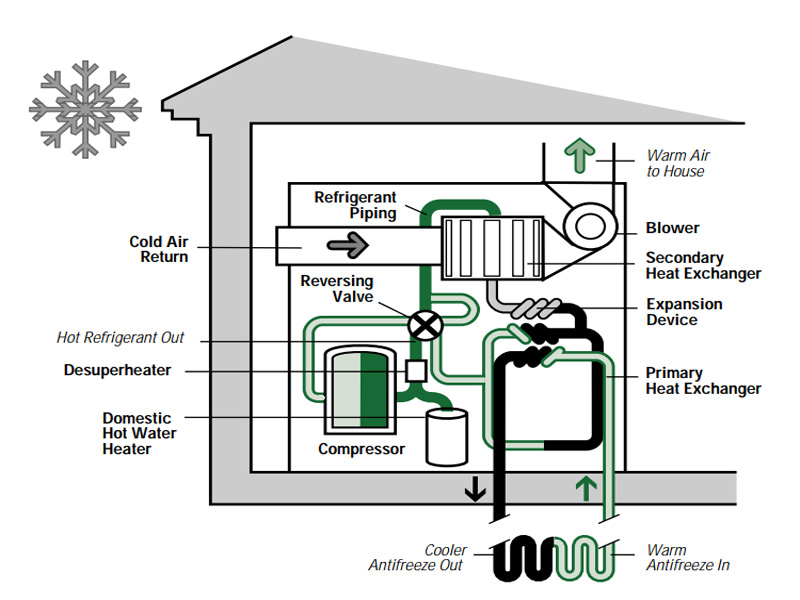Ground-Source Heat Pumps
Ground-source heat pumps use the earth or ground water as a source of thermal energy in heating mode, and as a sink to reject energy when in cooling mode. These types of systems contain two key components:
- Ground Heat Exchanger: This is the heat exchanger used to add or remove thermal energy from the earth or ground. Various heat exchanger configurations are possible, and are explained later in this section.
- Heat Pump: Instead of air, ground-source heat pumps use a fluid flowing through the ground heat exchanger as their source (in heating) or sink (in cooling).
On the building side, both air and hydronic (water) systems are possible. Operating temperatures on the building side are very important in hydronic applications. Heat pumps operate more efficiently when heating at lower temperatures of below 45 to 50°C, making them a better match for radiant floors or fan coil systems. Care should be taken if considering their use with high temperature radiators that require water temperatures above 60°C, as these temperatures generally exceed the limits of most residential heat pumps.
Depending on how the heat pump and ground heat exchanger interact, two different system classifications are possible:
- Secondary Loop: A liquid (ground water or anti-freeze) is used in the ground heat exchanger. The thermal energy transferred from the ground to the liquid is delivered to the heat pump via a heat exchanger.
- Direct Expansion (DX): A refrigerant is used as the fluid in the ground heat exchanger. The thermal energy extracted by the refrigerant from the ground is used directly by the heat pump – no additional heat exchanger is needed.
In these systems, the ground heat exchanger is a part of the heat pump itself, acting as the evaporator in heating mode and condenser in cooling mode.
Ground-source heat pumps can serve a suite of comfort needs in your home, including:
- Heating only: The heat pump is used only in heating. This can include both space heating and hot water production.
- Heating with “active cooling”: The heat pump is used in both heating and cooling
- Heating with “passive cooling”: The heat pump is used in heating, and bypassed in cooling. In cooling, fluid from the building is cooled directly in the ground heat exchanger.
Heating and “active cooling” operations are described in the following section.
Major Benefits of Ground-Source Heat Pump Systems
Efficiency
In Canada, where air temperatures can go below –30°C, ground-source systems are able to operate more efficiently because they take advantage of warmer and more stable ground temperatures. Typical water temperatures entering the ground-source heat pump are generally above 0°C, yielding a COP of around 3 for most systems during the coldest winter months.
Energy Savings
Ground-source systems will reduce your heating and cooling costs substantially. Heating energy cost savings compared with electric furnaces are around 65%.
On average, a well designed ground-source system will yield savings that are about 10-20% more than would be provided by a best in class, cold climate air-source heat pump sized to cover most of the building heating load. This is due to the fact that underground temperatures are higher in winter than air temperatures. As a result, a ground-source heat pump can provide more heat over the course of the winter than an air-source heat pump.
Actual energy savings will vary depending on the local climate, the efficiency of the existing heating system, the costs of fuel and electricity, the size of the heat pump installed, borefield configuration and the seasonal energy balance, and the heat pump efficiency performance at CSA rating conditions.
How Does a Ground-Source System Work?
Ground-source heat pumps consist of two main parts: A ground heat exchanger, and a heat pump. Unlike air-source heat pumps, where one heat exchanger is located outside, in ground-source systems, the heat pump unit is located inside the home.
Ground heat exchanger designs can be classified as either:
- Closed Loop: Closed-loop systems collect heat from the ground by means of a continuous loop of piping buried underground. An antifreeze solution (or refrigerant in the case of a DX ground-source system), which has been chilled by the heat pump’s refrigeration system to several degrees colder than the outside soil, circulates through the piping and absorbs heat from the soil.
Common piping arrangements in closed loop systems include horizontal, vertical, diagonal and pond/lake ground systems (these arrangements are discussed below, under Design Considerations). - Open Loop: Open systems take advantage of the heat retained in an underground body of water. The water is drawn up through a well directly to the heat exchanger, where its heat is extracted. The water is then discharged either to an above-ground body of water, such as a stream or pond, or back to the same underground water body through a separate well.
The selection of outdoor piping system depends on the climate, soil conditions, available land, local installation costs at the site as well as municipal and provincial regulations. For instance, open loop systems are permitted in Ontario, but are not permitted in Quebec. Some municipalities have banned DX systems because the municipal water source is the aquifer.
The Heating Cycle
Remark:
Some of the articles are taken from the Internet. If there is any infringement, please contact us to delete it. If you’re interesting in heat pump products,please feel free to contact OSB heat pump company,we are your best choice.
Post time: Nov-01-2022


